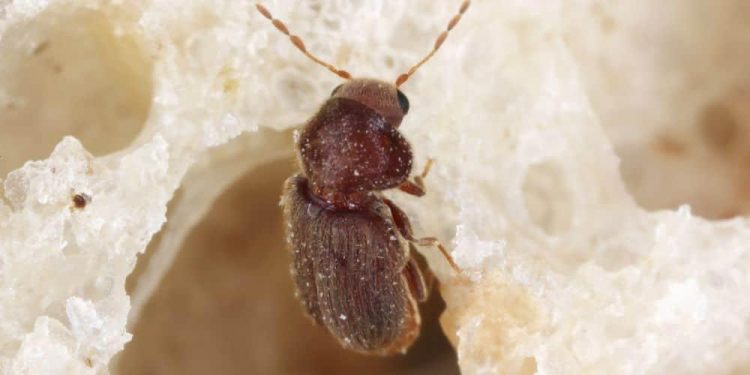A kitchen is a moist place where you store and use plenty of groceries, so it is expected to attract numerous insects. Finding tiny brown bugs in the kitchen is a pretty unpleasant experience for most people.
Therefore, learning to classify these creatures and find the best options to eliminate them can be beneficial. Otherwise, they may destroy stored food. Be aware that it is challenging since these bugs are small and look alike at first glance.
You are watching: 17 Tiny Brown Bugs In Kitchen (with Pictures)
Tiny Brown Bugs In The Kitchen
Tiny brown bugs in the kitchen Bug type Size Color Drugstore beetles 0.09 to 0.14 inches
(2.25 – 3.5 mm)
Uniform brown to reddish brown Foreign grain beetles 0.08 inches (2 mm) Reddish-brown Warehouse beetles 0.12 to 0.18 inches
(3 – 4.7 mm)
Dark with yellow to brown patches Khapra beetles 0.07 to 0.15 inches
(1.8 – 3.8 mm)
Reddish brown or brown to black Flour beetles 0.14 to 0.24 inches
(3.5 – 6 mm)
Reddish brown Spider beetles 0.08 to 0.20 inches
(2 – 5 mm)
Reddish-brown to black Saw-toothed grain beetles 0.10 to 0.12 inches
(2.5 – 3 mm)
Reddish-brown, rusty brown, or dark brown Common fruit flies 0.12 inches (3 mm) Yellow-brown Pantry moths 0.12 to 0.16 inches
(3 – 4 mm)
Copper-reddish brown Weevils 0.12 to 0.39 inches
(3 – 10 mm)
Brownish to black Rice weevils 0.10 to 0.14 inches
(2.5 – 3.5 mm)
Dull reddish-brown Granary weevils 0.10 to 0.20 inches
(2.5 – 5 mm)
Reddish-brown to dark brown-black Bean weevils 0.08 to 0.20 inches
(2 – 5 mm)
Grayish-brown with a black, red-brown, or white mottled pattern Psocids mites 0.02 to 0.19 inches
(0.5 – 4.8 mm)
Brown, gray, or white Firebrats 0.25 to 0.50 inches
(6.35 – 12.7 mm)
Brown or grayish-black Ants 0.06 to 1 inch
(1.5 t- 25 mm)
Brown, reddish, yellow, or black Cockroaches Brown-banded – 0.50 inches
(12.7 mm)
Reddish-brown to black Oriental – 1 inch (25.50 mm) American – 1.50 to 2 inches
(38 – 51 mm)
1. Drugstore beetles
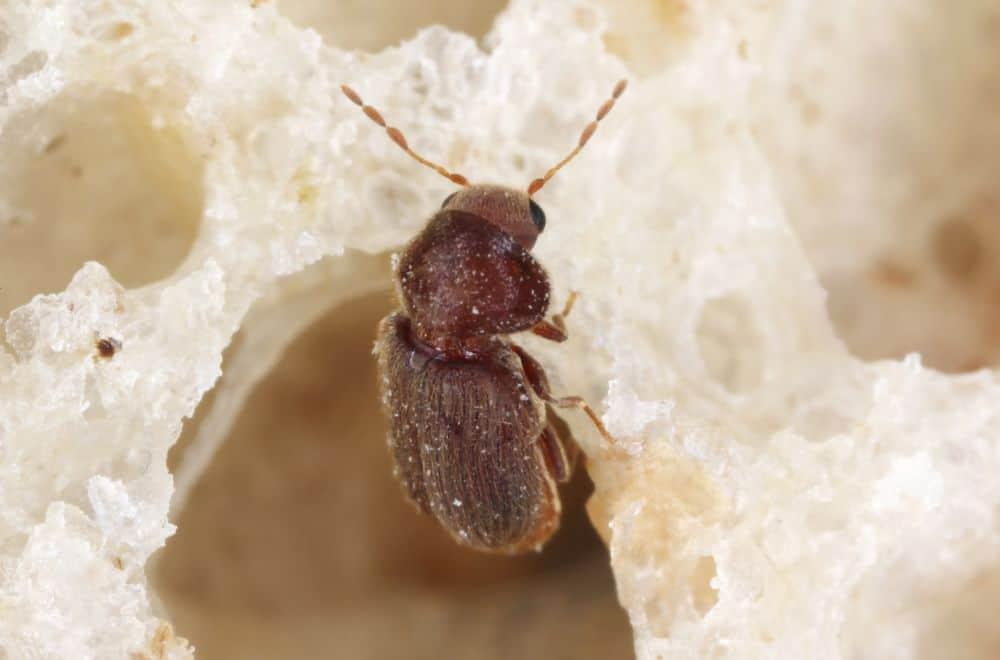
Uniformly brown to reddish-brown, coffee bean-like Drugstore beetles tend to consume some prescription drugs. You can find them in areas with temperatures over 70 F (21 C) and high humidity levels, making your kitchen an ideal habitat.
They can invade stored food, like bread, flour, cookies, spices, and dry fruits. Keep in mind that these pests are also capable of damaging books, wool and wooden materials, leather, and even piercing plastic bags and aluminum foils!
2. Foreign grain beetles (Plaster house bugs)
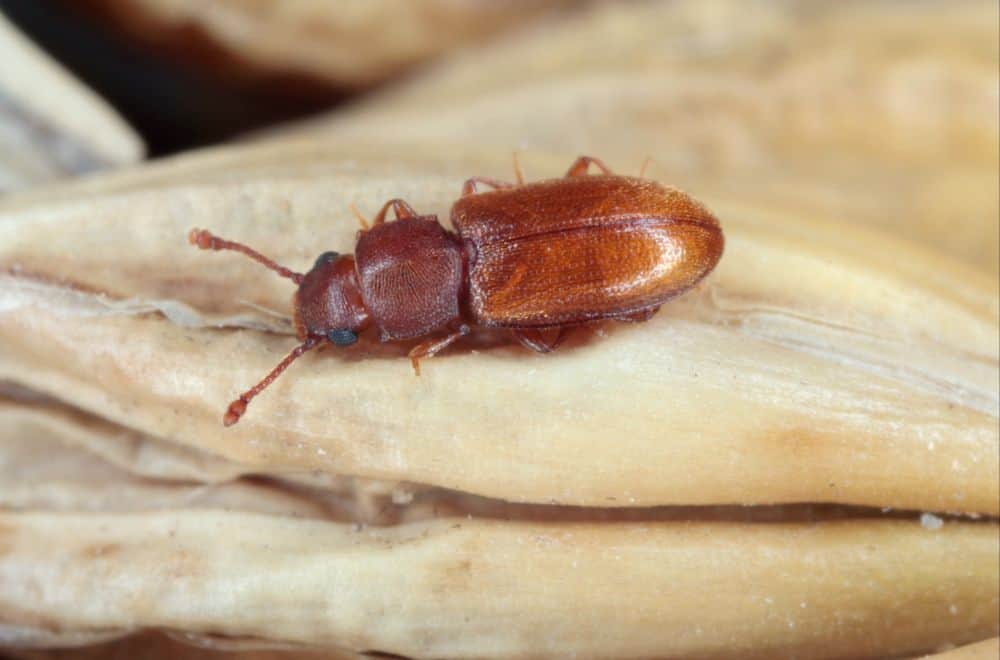
These beetles typically live in newly constructed buildings, so people sometimes call them New house bugs. Their invasion is at its peak in a period from August and September, and you should look for them in places with humidity over 60%, like the kitchens and bathrooms.
Their favorite meals include flour, grains, herbs, figs, dates, oilseeds, biscuits, cookies, and spices. Remember that you need a magnifying glass to identify these tiny creatures.
3. Warehouse beetles
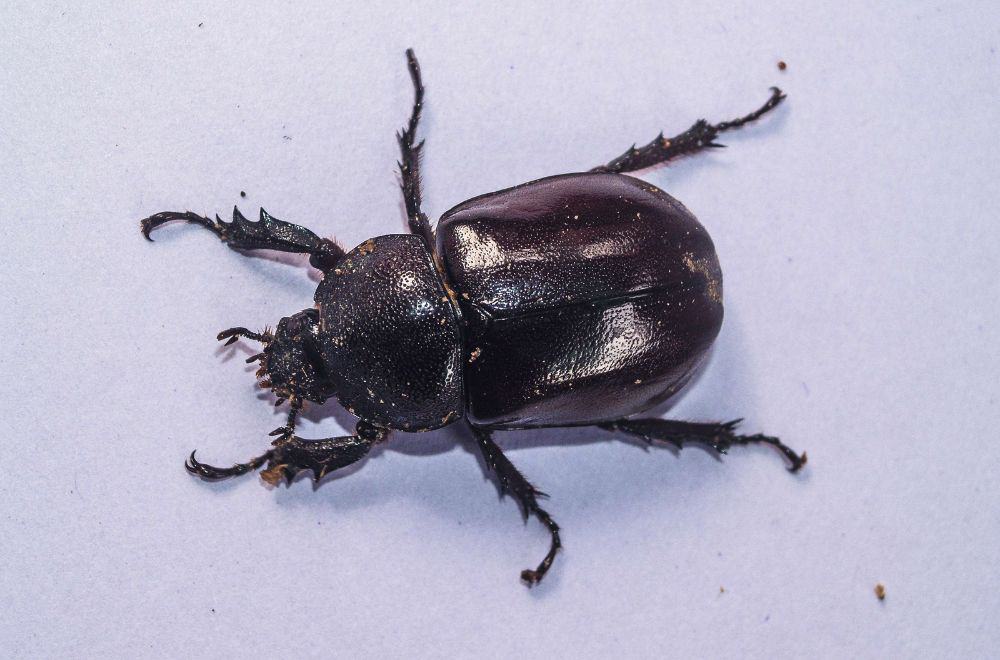
These pests are excellent flyers with a preference for stored food but are relatively rare in the kitchen. You can find them eating a variety of food, including:
- Corn, barley, beans
- Candies, cookies
- Cereals, nuts, cocoa
- Flour, fish meal, powdered milk
- Spices
- Spaghetti, potato chips, oatmeal
- Pet food
- Dead insects (ladybugs and boxelder bugs)
These bugs are harmless to your family and pets, but infected food can cause gastrointestinal problems.
4. Khapra beetles (Cabinet beetles)
These voracious bugs are in a group of the worst existing invasive pest species that infest stored seeds and grains. Even though they have wings, they never fly and spend time nibbling little grain parts.
Interestingly, they never ingest complete grains but damage huge amounts of stored food by nibbling them. You can expect Khapra beetles to survive under extreme conditions for a long, including freezing temperatures and those up to 140 F (60 C). They live worldwide, except in Australia.
5. Flour beetles
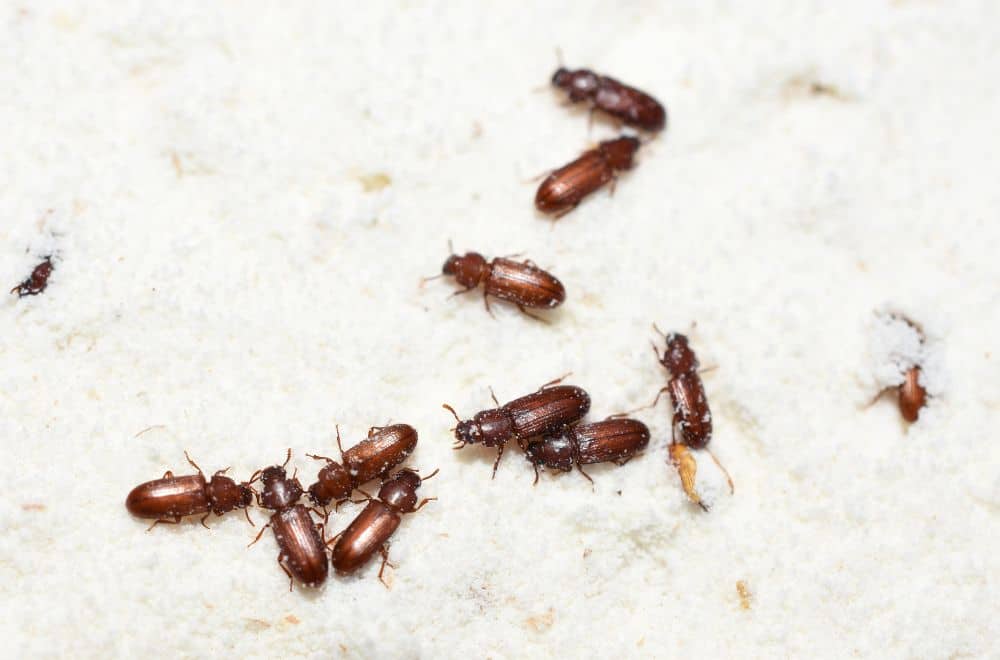
These tiny reddish-brown bugs are probably the most widespread insects in the kitchen. You can find them in flour, grains, nuts, beans, and dried fruit. They are primarily scavenger pantry pests incapable of feeding on fresh food.
If you spot them in your home, you can consider all grains and flour spoiled by their larvae, stinking secretions, and feces.
6. Spider beetles
American spider beetles are tiny brown spider-like bugs that sometimes invade kitchens and contaminate grain-based food. They are not picky eaters and consume various ingredients, including flour, pasta, grains, cereal, beans, nuts, and dried fruit.
7. Saw-toothed grain beetle
These tiny beetles are recognizable brown bugs with saw-like teeth arranged on both body sides. You can find them in your kitchen, nibbling flour, dried cereals, pasta, noodles, sugar, and fried meat.
8. Common fruit flies
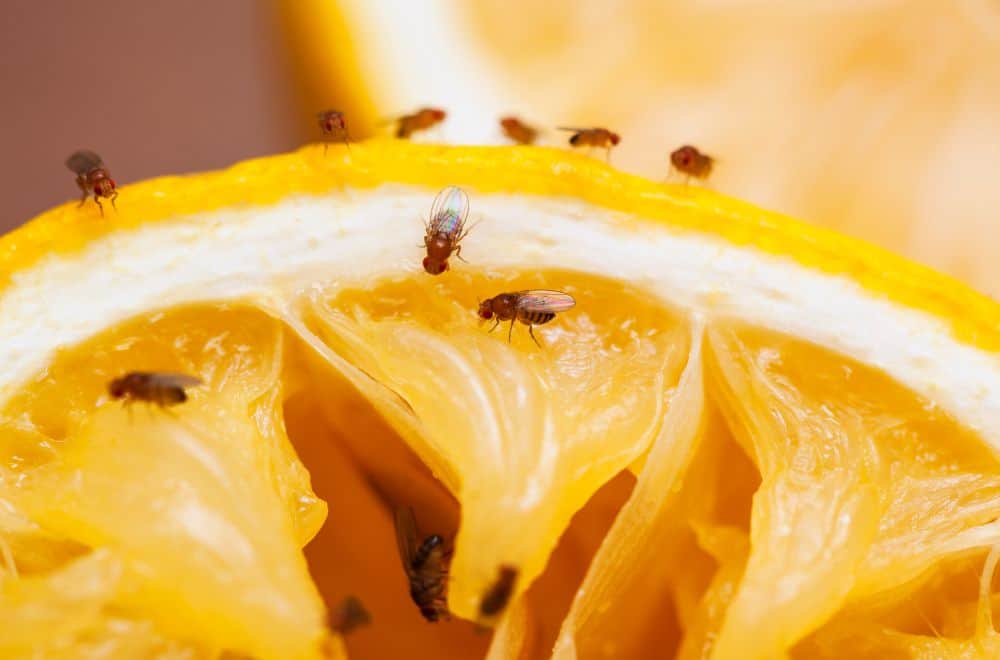
Common fruit flies are tiny, yellow-brown, winged bugs that fly around fruit bowls, attracted by sweet food. On the other hand, their larvae feed on garbage, mainly decaying organic matter.
9. Pantry moths (Indian meal moths)
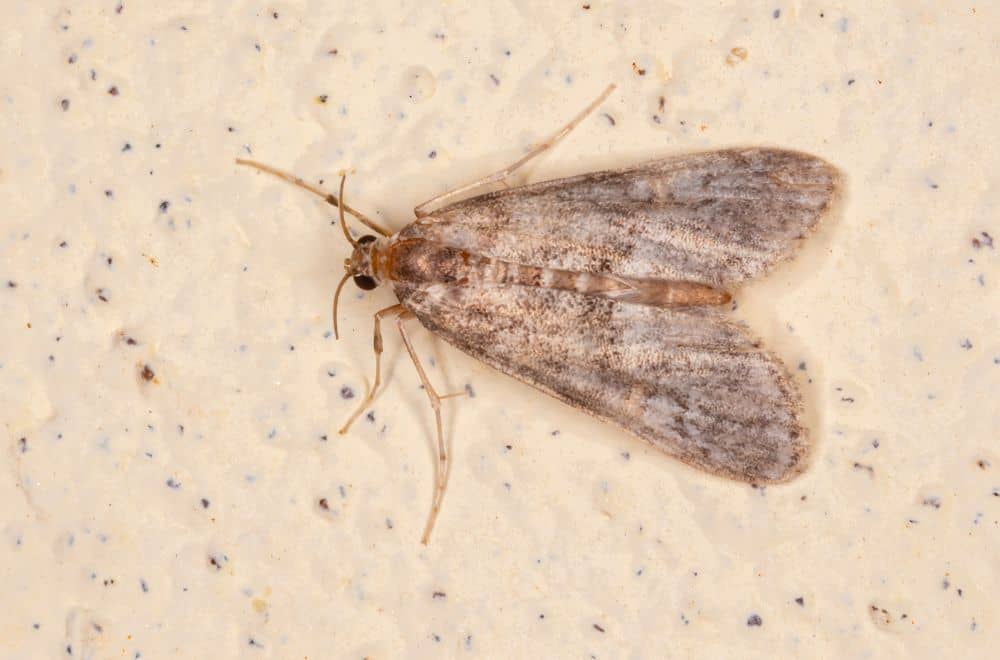
Indian meal moths are small pests commonly found in kitchens and pantries. They typically invade homes after being released from packaged food full of eggs and larvae.
Larvae feed on grains before transforming into adults, which quickly leave bags. You can be sure these creatures are present after noticing tiny holes in food packaging.
10. Weevils
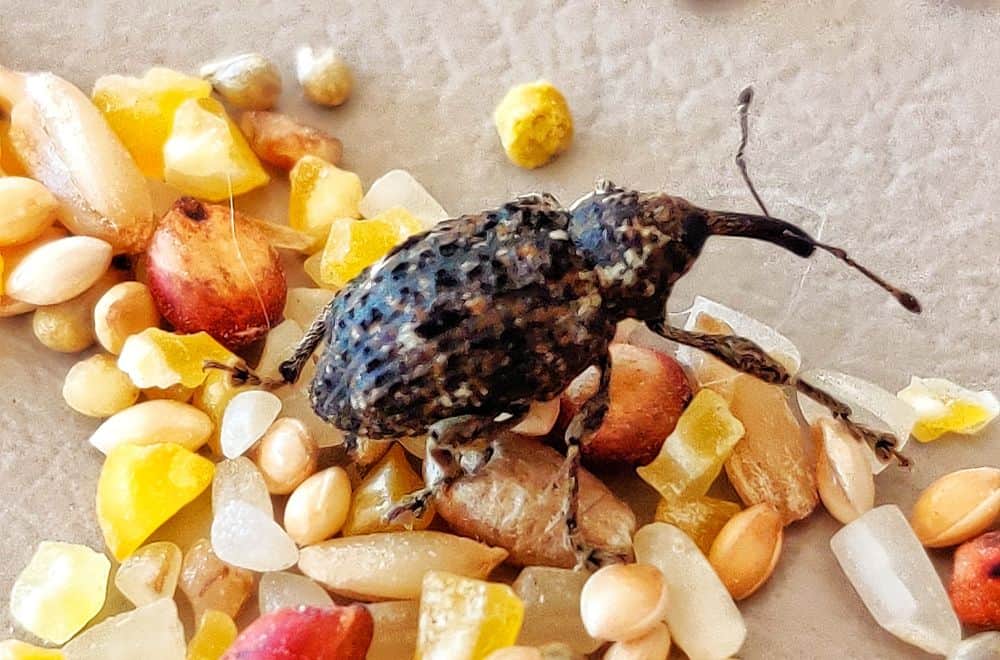
Weevils are typical bugs you can find in your kitchen feeding on grains and plants. When you see them around, you can be sure there is an infested spot in the house. That hidden nest is always in corners with the high temperature and humidity.
11. Rice weevils

These predominantly brown tiny bugs with black spots can fly and are quickly attracted by artificial light. Once they come to your kitchen, they contaminate all grain types, including rice, cereals, cashew nuts, wheat, oats, dried beans, popcorn, and corn.
Interestingly, these weevils also like fruit, such as grapes, apples, and pears. They use their strong jaws to break through food packets and thin plastic to reach the food!
12. Granary weevils
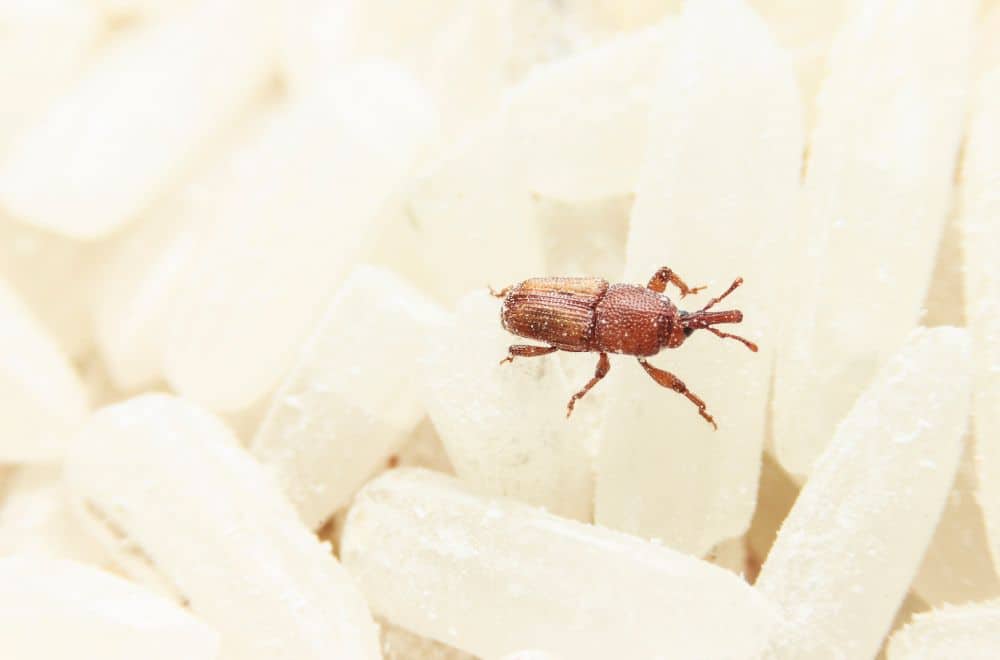
These common wingless pests of grains prefer living in cooler climates and typically invade places with stored grains, cereals, and seeds.
Adults make tiny holes in grains to make a nest for laying eggs and allow larvae to feed on grain kernel. They are harmless to people and animals but can sometimes damage your wooden furniture.
13. Bean weevils
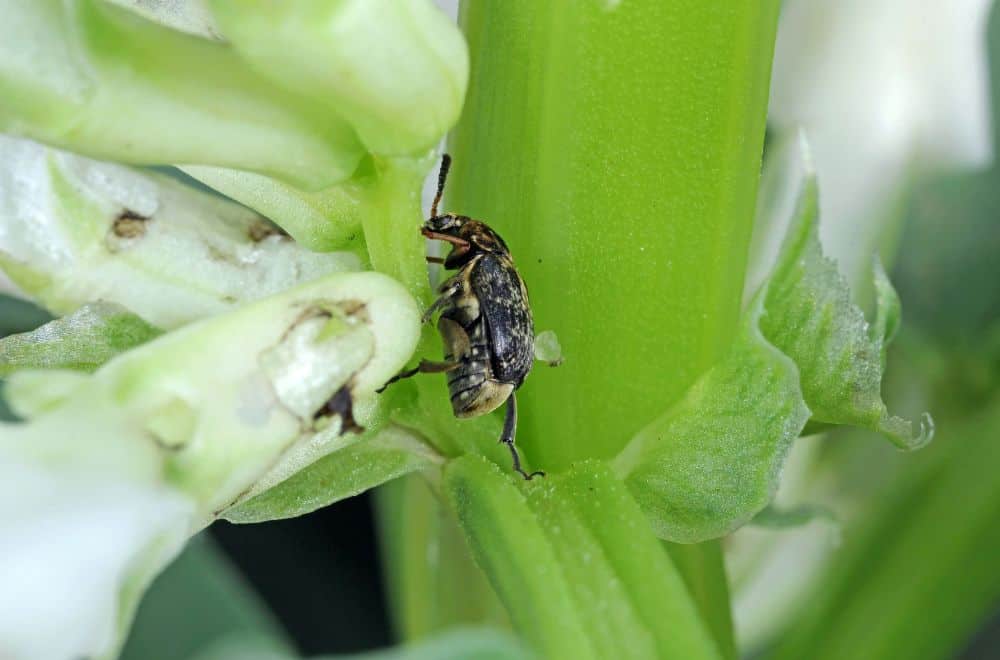
Bean weevils differentiate from other weevils for their tear-shaped body and absence of elongated snouts typical for others. You can find these 0.08 to 0.20 inches (2 – 5 mm) long creatures in your kitchen, tending to infect primarily legumes, peas, and beans.
14. Psocids mites (Booklice)
Booklice are tiny brown soft-bodied insects that choose to feed on the molds forming on the grain surface. Since they enjoy a moist environment, you can primarily find them in the kitchen. Fortunately, these mites are harmless and don’t contaminate food. It is enough to wash grains in hot water and use them.
15. Firebrats
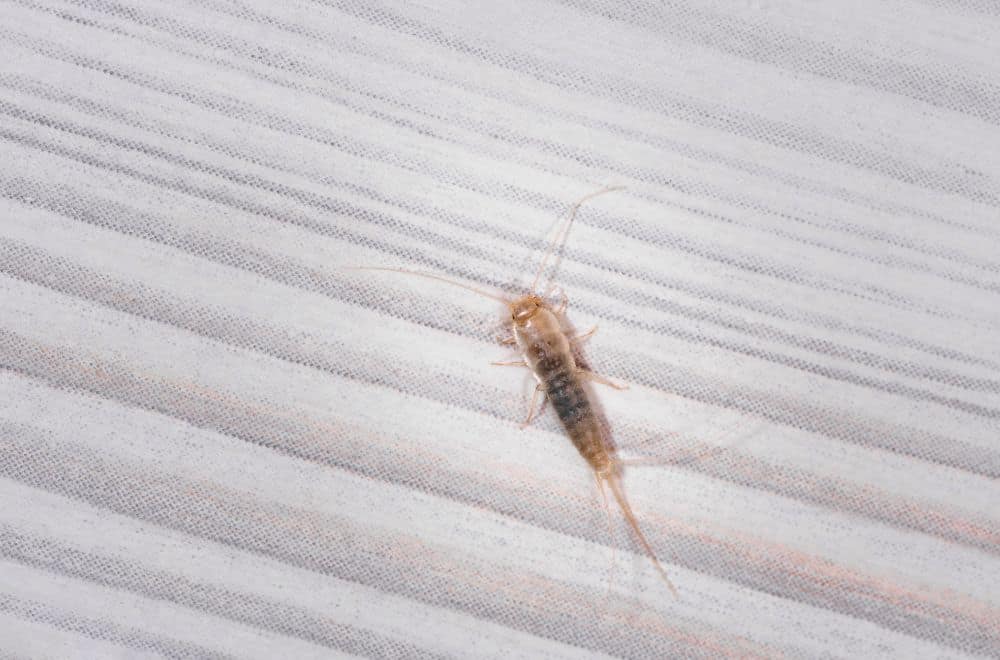
Firebrats are brown or grayish-black oval bugs without wings, typical for the Southern regions in the US. Besides living under rocks or in mulch, they can enter older houses.
You can expect Firebrats to occupy rooms with increased humidity levels and temperatures of about 74 F (23 C), like your kitchen and bathroom. They are scavengers and look for crumbs, starch, dead insects, paper products, glue, and wallpaper paste.
16. Ants
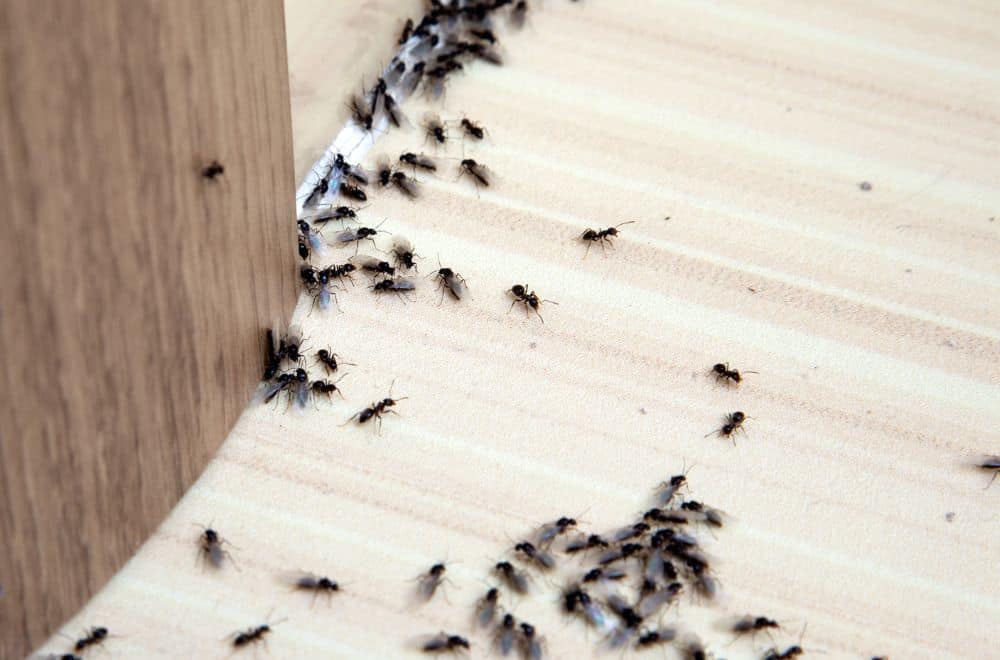
Over 12,000 different ant species live worldwide except in Antarctica. Their three-part bodies are similar, but they significantly vary in color. Tiny brown ants are common kitchen visitors that feed on food scraps, spills, and crumbs.
You attract them with dirty garbage bins, dishes left in the sink, and improperly stored food. Eliminating these creatures is vital to prevent possible health issues.
17. Roaches
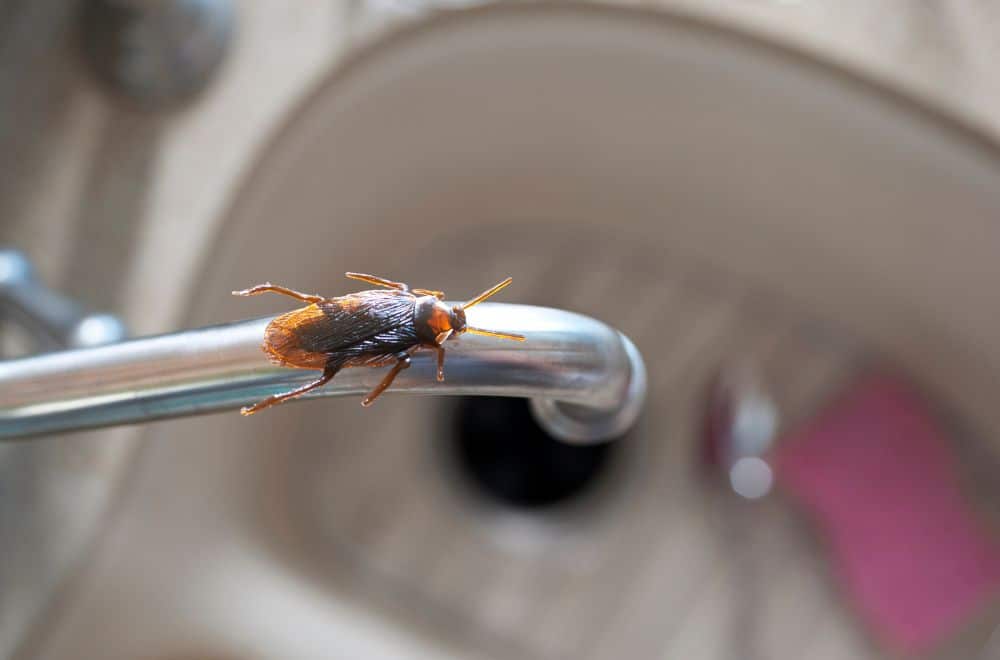
Brown or black roaches can live for about a year, typically in warm, moist areas, especially kitchens. They require plenty of food and water they find near water pipes, garbage cans, and dirty places under sinks, fridges, and stoves.
These nasty pests consume anything they find, including grease, dead insects, and food crumbs. They can quickly jeopardize your health since they spread numerous bacteria. Unfortunately, eliminating cockroaches can be highly challenging.
Ways to Eliminate and Prevent Tiny Brown Bugs in Kitchen
The best option is to prevent tiny brown bugs from entering your kitchen. Always check bought groceries thoroughly since they can carry eggs, larvae, or even adult insects.
Store your food correctly, regularly discard contaminated ingredients, never let dirty dishes sit in the sink, and keep your kitchen clean. There are also a few technical things you should try to keep your home pest-free, such as:
- Installing window screens
- Sealing cracks and gaps in walls
- Cleaning the drains
- Fixing water leakages in the kitchen and bathroom
When tiny brown bugs once appear in your kitchen, it becomes challenging to eliminate them. However, you can try a few remedies, which will be more or less successful depending on the bug you are dealing with. Let’s take a look.
1. Baking soda
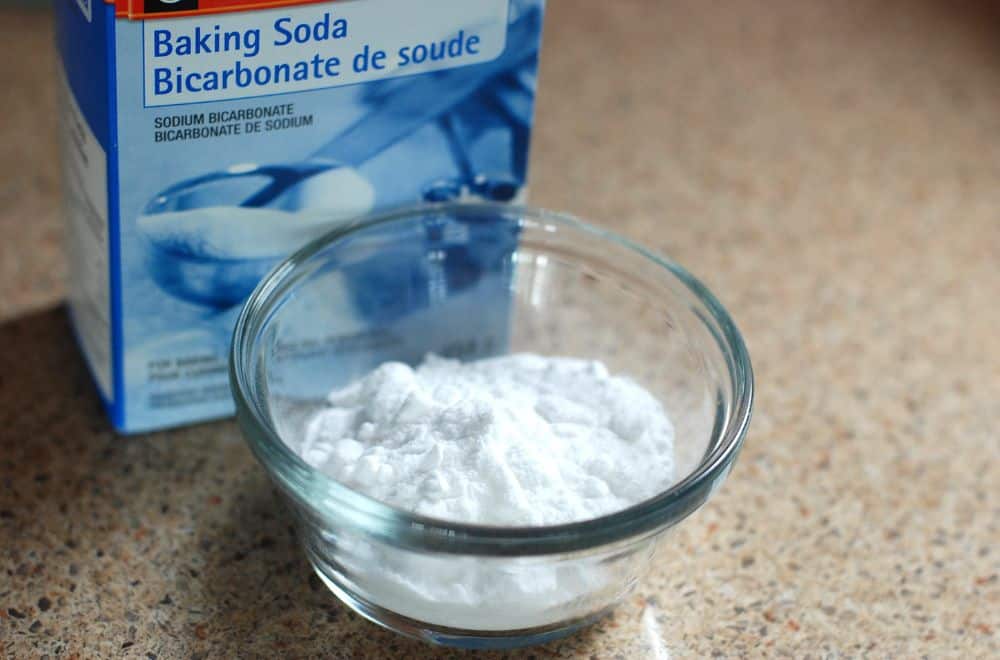
Baking soda is a well-known repellent and pest control agent, so you can use it to get rid of bugs in your kitchen. Sprinkle it evenly in the invaded area to repel or kill insects, primarily ants and cockroaches.
2. Garlic
Tiny brown bugs living in kitchens and bathrooms hate the garlic smell, making this veggie an efficient repellent. The best solution is to cut garlic cloves in halves and distribute them in the corners and the most endangered places.
3. Bay leaves
This popular herb is an unavoidable seasoning most chefs use for delicious meals. However, you can use leaves instead of harmful insecticides to repel bugs in your kitchen. Place them on shelves or in cabinets for the full effect.
4. Peppermint oil
This oil is a natural repellent highly efficient against ants, beetles, and fleas. Add a few drops to the spraying bottle filled with water. Shake the mix before use and spray it around door frames, windowsills, and kitchen elements.
5. Neem oil
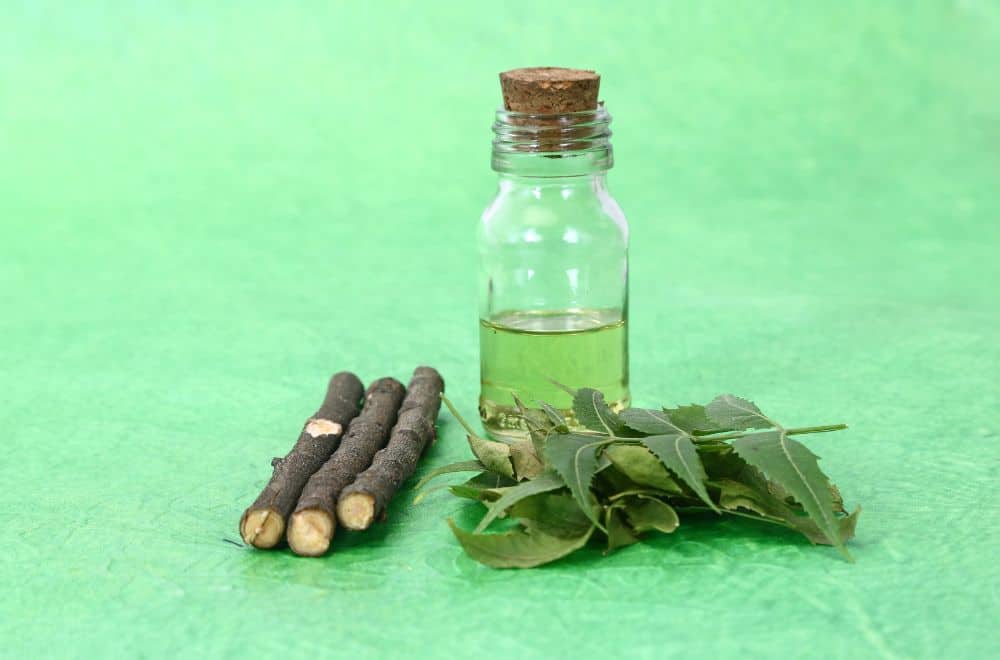
Neem oil is a product of neem trees growing in India and Africa. Applying this natural repellent on the kitchen floor or plants is the best and safe method to kill bugs.
It reduces their feeding and growth and prevents them from laying eggs. There are no contraindications to this oil use since it is harmless to humans and animals.
6. Diatomaceous earth
Diatomaceous earth is made of fossilized diatom (algae) remains. You can use it for numerous purposes, including tiny brown and black bug elimination. The only thing you need to do is to dust this powder on invaded areas in your kitchen. Then, let it sit for several hours, and eventually vacuum it.
7. Borax
This white powder is an excellent household cleaner that additionally disinfects surfaces. You can use it to successfully eliminate tiny black bugs in the kitchen, including dirty spaces under the sink, fridge, stove, and cupboards.
It is enough to sprinkle it on infested areas. However, keep it away from your kids and pets to prevent harmful effects after swallowing large quantities.
8. Insecticides

Nowadays, you can find numerous liquid, aerosol, or powder-form insecticides on the market. You should sprinkle or spray them over infected areas to eliminate bugs. Remember to keep these chemicals away from kids, pets, and your food.
9. Traps
You can make a few DIY traps or buy finished products to deter brown bugs from your kitchen or kill them. Your best options are traps made of beer, balsamic vinegar, white vinegar, syrup, and honey. Picking out the right ingredients is crucial and depends on the bug types you want to eliminate.
10. Professional help
Despite numerous natural methods and excellent insecticides, your fight with tiny brown bugs can sometimes be unsuccessful. The reason is a heavy bug infestation and undiscovered primary sources of their invasion. In this case, a professional pest control company is the ultimate solution.
Summary
You can recognize several tiny brown bugs that can appear in your kitchen. Luckily, they won’t directly jeopardize your health but can severely threaten your stored groceries. Therefore, your priority should be kitchen element disinfection, keeping your kitchen clean, and eliminating bugs.
Sharing is caring!
Source: https://gardencourte.com
Categories: Kitchens

